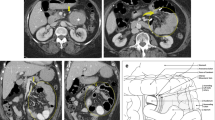Abstract
Spontaneous rupture of the esophagus (so-called Boerhaave’s syndrome) is considered a medical emergency. It carries a significant mortality rate and requires prompt treatment. The treatment of choice involves surgical repair of the esophageal defect, usually accomplished via laparotomy, thoracotomy, or both to accomplish esophageal repair and mediastinal debridement. We have treated an elderly patient with severe comorbidities with a minimally invasive approach, achieving a successful complete repair. Long-term endoscopic and radiologic follow-up confirm the good results.
Similar content being viewed by others
References
Boerhaave H (1724) Atrocis, nec descripti prius, morbid historia secundum artis leges conscripta, lugduni batavorum, bontes teniana. Medici 60
Skinner DB, Little AG, DeMeester TR (1998) Management of esophageal perforation. Am J Surg 139:760–764
Jones WG, Ginsberg RJ (1992) Esophageal perforation: a continuing challenge. Ann Thorac Surg 53:534–543
Lang MH, Bruns DH, Schmitz B, Wuerl P (2006) Esophageal perforation: principles of diagnosis and surgical management. Surg Today 36:332–340
Abbas G, Schuchert MJ, Pettiford BL, Pennathur A, Landrenau J, Landrenau J, Luketich J, Landrenau RJ (2009) Contemporaneous management of esophageal perforation. Surgery 146:749–756
Orringer MB, Stirling MC (1990) Esophagectomy for esophageal disruption. Ann Thorac Surg 49:35–43
Johnson J, Schwegman CW, Kirby CK (1956) Esophageal exclusion for persistent fistula following spontaneous rupture of the esophagus. J Thorac Surg 32:827–831
Whyte RI, Iannettoni MD, Orringer MB (1995) Intrathoracic esophageal perforation. The merit of primary repair. J Thorac Cardiovasc Surg 109:140–146
Ohri SK, Liakakos TA, Pathi V, Thowsend ER, Fountain SW (1993) Primary repair of iatrogenic esophageal perforation and Boerhaave’s syndrome. Ann Thorac Surg 55:603–606
Ashrafi AS, Awais O, Alvelo-Rivera M (2007) Minimally invasive management of Boerhaave’s syndrome. Ann Thorac Surg 83:317–319
Landen S, El Nakadi I (2002) Minimally invasive approach to Boerhaave’s syndrome: a pilot study of three cases. Surg Endosc 16:1354–1357
Dapri G, Dumont H, Roman A, Stevens E, Himpens J, Cadiere GB (2008) A delayed Boerhaave’s syndrome diagnosis treated by thoracoscopy in prone position. Minerva Chir 63:237–240
Scott HJ, Rosin RD (1995) Thoracoscopic repair of transmural rupture of the oesophagus (Boerhaave’s syndrome). J R Soc Med 88:414–415
Dumonceau JM, Deviere J, Capello M, Van Gossum A, Cremer M (1996) Endoscopic treatment of Boerhaave’s syndrome. Gastrointest Endosc 44:477–479
Eubanks PJ, Nguyen D, Procaccino F, Eysselein VE, Klein SR (1999) Case of Boerhaave’s syndrome treated with a metallic self-expandable metallic stent. Gastrointest Endosc 49:780–783
Kiev J, Amendola M, Bouhaidar D, Sandhu BS, Zhao X, Maher J (2007) A management algorithm for esophageal perforation. Am J Surg 194:103–106
Salminen P, Gullichsen R, Laine S (2009) Use of self-expandable metal stents for the treatment of esophageal perforations and anastomotic leaks. Surg Endosc 23:1526–1530
Freeman RK, van Woerkom JM, Vyveberg A, Ascioti AJ (2009) Esophageal stent placement for the treatment of spontaneous esophageal perforations. Ann Thorac Surg 88:194–198
Leers JM, Vivaldi C, Schäfer H, Bludau M, Brabender J, Lurje G, Herbold T, Hölscher AH, Metzger R (2009) Endoscopic therapy for esophageal perforation or anastomotic leak with a self-expandable metallic stent. Surg Endosc 23(10):2258–2262
Author information
Authors and Affiliations
Corresponding author
Electronic supplementary material
Below is the link to the electronic supplementary material.
Supplementary material 1 (MPG 37866 kb)
Supplementary material 2 (MPG 70362 kb)
Supplementary material 3 (MPG 16958 kb)
Rights and permissions
About this article
Cite this article
Fiscon, V., Portale, G., Frigo, F. et al. Spontaneous rupture of middle thoracic esophagus: thoracoscopic treatment. Surg Endosc 24, 2900–2902 (2010). https://doi.org/10.1007/s00464-010-1056-4
Received:
Accepted:
Published:
Issue Date:
DOI: https://doi.org/10.1007/s00464-010-1056-4




